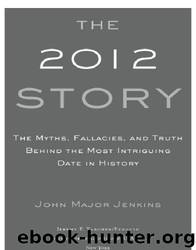The 2012 Story by John Major Jenkins

Author:John Major Jenkins
Language: eng
Format: epub
Publisher: Penguin USA, Inc.
MANY SCHOLARS MOVING IT FORWARD
I realize that I can be critical of scholars and New Agers in equal measure, but in this section I want to make it clear that I have been inspired and informed by Maya scholars past and present. Many scholars are doing incredible trail-blazing work and are driven by their own love of Maya culture. It’s rare for any specialist to become a full-time epigrapher. The new epigraphers are pursuing their interest as a sideline, attending conferences at their own expense, often finding it difficult to get their research published in official journals. It’s the digital age, so debates and think tanks unfold today in private e-mails, teleconferences, and on e-list discussion boards. Scholars whose perspectives I disagree with and critique in this book are also the same scholars who have provided insights and breakthroughs. But everything must be assessed with clarity and discernment. As far as I’m concerned, this is how it should be. Blindly following authority figures occurs in academia as much as in New Age cults and anywhere else. Often, a sense of propriety prevents authority figures from being corrected on basic errors. The entire thing is a process, and despite career ambitions professional scholars and independent researchers alike share a desire to understand more deeply what the ancient Maya civilization was about.
Scholars currently doing important work include Susan Milbrath, Elizabeth Newsome, Prudence Rice, Karen Bassie, Julia Kappelman, Victoria Bricker, Barbara MacLeod, Barbara Tedlock, Merle Greene Robertson, Martha Macri, and Gabrielle Vail. Noteworthy pioneers of the past include Tatiana Prouskouriakaoff, Linda Schele, Maud Oakes, Maud Makemson, Zelia Nuttall, and Doris Heyden. Notice that these are all women. A lot of them specialize in hard-core scientific disciplines—archaeology, astronomy, calendrics, and mathematics. They prove that these traditionally male domains are simply not gender-specific. Unlike other high-level disciplines (with the exception, perhaps, of women’s studies), Mesoamerican studies is overflowing with brilliant female scholars. I’m not sure why this is so, but I think it needs to be said.
Barb MacLeod is a brilliant investigator with many interests. In addition to consistently offering breakthrough readings of tenaciously inscrutable hieroglyphic texts, she is a passionate aviation stunt flyer and instructor, a guitar-playing singer-songwriter, cave explorer, and artist (she did the Cycle 7 cartoon in Chapter 1). She first traveled from Seattle to Belize in 1970 to explore caves. In a fortuitous occurrence, she soon returned to map out caves for the archaeology department of the Peace Corps. She pursued this for five years, visiting Maya temple sites throughout Mesoamerica while studying the hieroglyphs. Around 1973, she adapted Morley’s Long Count table in The Ancient Maya, extending it out to December of 2012.
After getting her degree at the University of Texas in Austin, she circulated a series of epigraphic observations in the late 1980s and 1990s called “North Austin Notes.” It was one of these, from 1991, called “Maya Genesis: The Glyphs,” that spelled out the decipherment of the “three-hearthstone” hieroglyph, connecting it with the three stars in Orion. This
Download
This site does not store any files on its server. We only index and link to content provided by other sites. Please contact the content providers to delete copyright contents if any and email us, we'll remove relevant links or contents immediately.
Becoming Supernatural by Dr. Joe Dispenza(7105)
Tools of Titans by Timothy Ferriss(6946)
The Witchcraft of Salem Village by Shirley Jackson(6584)
Inner Engineering: A Yogi's Guide to Joy by Sadhguru(5895)
The Four Agreements by Don Miguel Ruiz(5511)
The Power of Now: A Guide to Spiritual Enlightenment by Eckhart Tolle(4755)
The Wisdom of Sundays by Oprah Winfrey(4626)
Room 212 by Kate Stewart(4107)
Fear by Osho(4085)
Pale Blue Dot by Carl Sagan(4001)
The David Icke Guide to the Global Conspiracy (and how to end it) by David Icke(3881)
Rising Strong by Brene Brown(3780)
Animal Frequency by Melissa Alvarez(3755)
How to Change Your Mind by Michael Pollan(3676)
Sigil Witchery by Laura Tempest Zakroff(3651)
Real Magic by Dean Radin PhD(3568)
Secrets of Antigravity Propulsion: Tesla, UFOs, and Classified Aerospace Technology by Ph.D. Paul A. Laviolette(3448)
The Art of Happiness by The Dalai Lama(3384)
Man and His Symbols by Carl Gustav Jung(3315)
